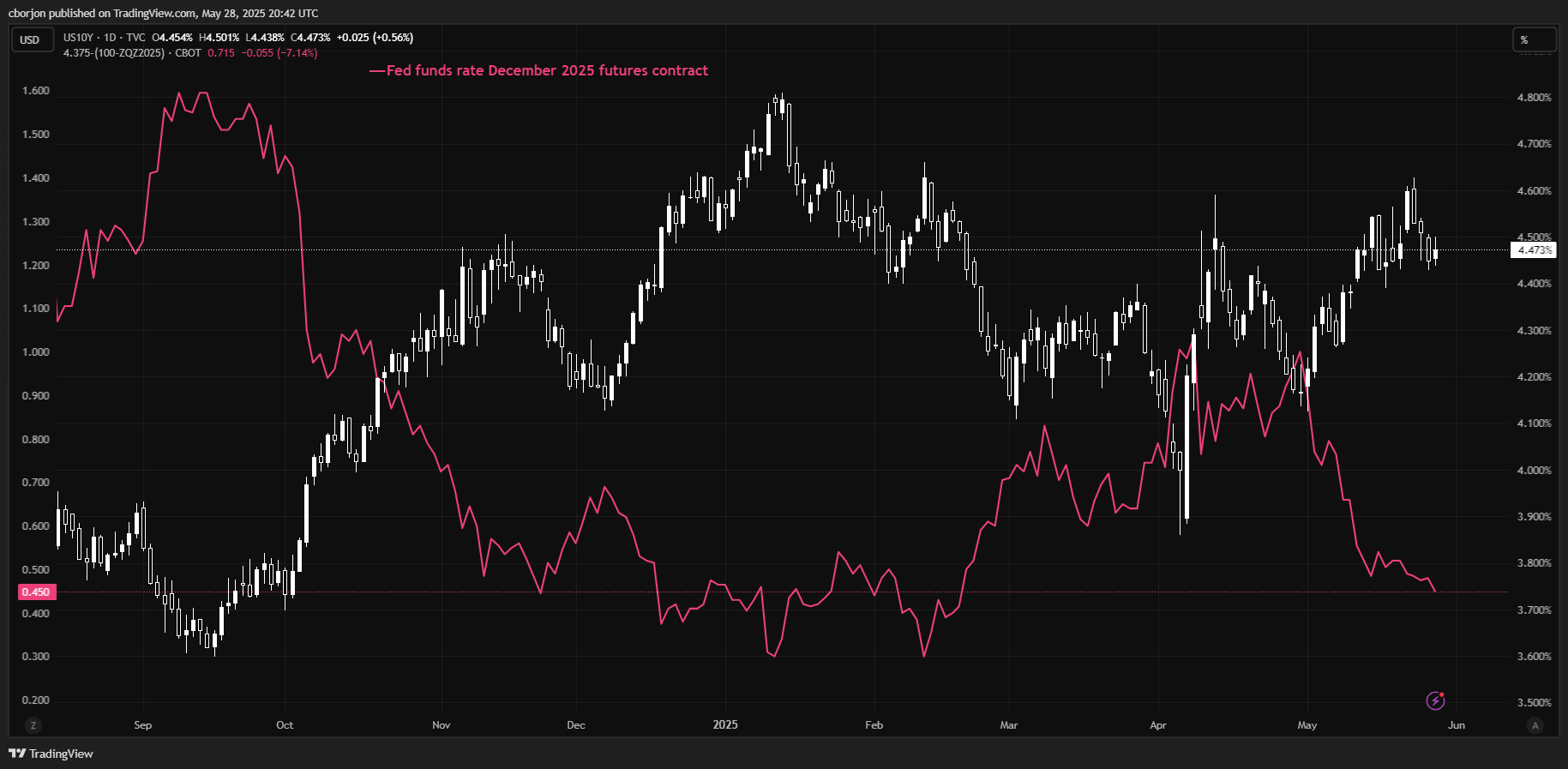- The 10 -year performance of the US rises to 4,473% while investors digest Fed concerns about inflation and tariffs.
- The 5 -year auction of 70,000 million dollars closes at 4,071%, slightly below the recent average, before the sale of 7 years on Thursday.
- Richmond’s weak Fed data underline the economic slowdown; All looks on GDP and the underlying PCE later this week.
The yields of the US Treasury bonds rose on Wednesday after the publication of the last minutes of the Federal Reserve meeting from May 6 to 7, which revealed the concerns of the US Central Bank on tariffs on tariffs and their impact on inflation and economic activity.
Treasury yields rise throughout the curve behind the fed cautious signals; Markets discount 45 basic points in cuts for the end of the year
The last minutes of the Federal Reserve revealed that officials support a cautious approach for fees settings in the middle of high economic uncertainty and growing risks of stagflation.
In response, monetary markets discounted 45 basic points of feat cuts for the end of the year.
The 2 -year bonus of the US, the most sensitive to changes in interest rates, rises a basic point and a half (BPS) to 3,994%.
The 10 -year Treasury bonus yield from the US is fired three basic points to 4,473%, since market participants remain skeptical that the Fed will lower the rates in the first half of the year.
The US 5 -year bond auction of 70,000 million dollars reached a maximum yield of 4,071%, exceeding the previous auction of 3,995%, although it remained below the average of six auctions of 4,204%. On Thursday, the US Treasury is expected to offer 44,000 million dollars in bonds to 7 years.
The US economic data were scarce, although Richmond’s Fed reported that manufacturing and services activity continued to show an economic deceleration in both sectors.
Facing this week, investors are attentive to the publication of GDP and labor indicators on Thursday. For Friday, the publication price index in Personal Consumption (PCE) is expected to publish the FED inflation indicator, decrease slightly.
Related news
-
The yields of US bonds fall while Trump’s tariff threats shake the markets
-
Last hour: Fed minutes showed that officials needed more clarity about perspectives
-
Fed: John Williams says he wants to prevent inflation from becoming highly persistent
10 -year performance of the US vs. federal fund rate December 2025 relaxation expectations

Fed Faqs
The monetary policy of the United States is directed by the Federal Reserve (FED). The Fed has two mandates: to achieve prices stability and promote full employment. Its main tool to achieve these objectives is to adjust interest rates. When prices rise too quickly and inflation exceeds the objective of 2% set by the Federal Reserve, it rises interest rates, increasing the costs of loans throughout the economy. This translates into a strengthening of the US dollar (USD), since it makes the United States a more attractive place for international investors to place their money. When inflation falls below 2% or the unemployment rate is too high, the Federal Reserve can lower interest rates to foster indebtedness, which weighs on the green ticket.
The Federal Reserve (FED) celebrates eight meetings per year, in which the Federal Open Market Committee (FOMC) evaluates the economic situation and makes monetary policy decisions. The FOMC is made up of twelve officials of the Federal Reserve: the seven members of the Council of Governors, the president of the Bank of the Federal Reserve of New York and four of the eleven presidents of the regional banks of the Reserve, who exercise their positions for a year in a rotary form.
In extreme situations, the Federal Reserve can resort to a policy called Quantitative Easing (QE). The QE is the process by which the Fed substantially increases the flow of credit in a stuck financial system. It is a non -standard policy measure used during crises or when inflation is extremely low. It was the weapon chosen by the Fed during the great financial crisis of 2008. It is that the Fed prints more dollars and uses them to buy high quality bonds of financial institutions. The one usually weakens the US dollar.
The quantitative hardening (QT) is the inverse process to the QE, for which the Federal Reserve stops buying bonds from financial institutions and does not reinvote the capital of the bonds that it has in portfolio that they expire, to buy new bonds. It is usually positive for the value of the US dollar.
Source: Fx Street
I am Joshua Winder, a senior-level journalist and editor at World Stock Market. I specialize in covering news related to the stock market and economic trends. With more than 8 years of experience in this field, I have become an expert in financial reporting.





